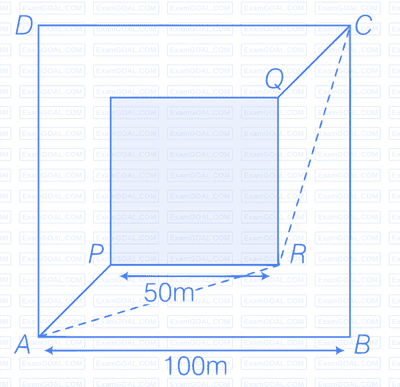A man wants to reach from A to the opposite corner of the square C. The sides of the square are 100 m. A central square of 50m × 50m is filled with sand. Outside this square, he can walk at a speed 1 m/s. In the central square, he can walk only at a speed v m/s (v < 1). What is the smallest value of v for which he can reach faster via a straight path through the sand than any path in the square outside the sand?

Consider adjacent diagram.

Time taken to go from A to C via straight line path APQC through the S and
$ T_{\text{sand}} = \frac{AP + QC}{1} + \frac{PQ}{v} = \frac{25\sqrt{2} + 25\sqrt{2}}{1} + \frac{50\sqrt{2}}{v}\\ = 50\sqrt{2} + \frac{50\sqrt{2}}{v} = 50\sqrt{2} \left( \frac{1}{v} + 1 \right) $
Clearly from figure the shortest path outside the sand will be ARC.
Time taken to go from A to C via this path
$ T_{\text{outside}} = \frac{AR + RC}{1} $
Clearly,
$ AR = \sqrt{75^2 + 25^2} = \sqrt{75 \times 75 + 25 \times 25}\\ = 5 \times 5\sqrt{9 + 1} = 25\sqrt{10} \text{ m} $
$ RC = AR = \sqrt{75^2 + 25^2} = 25\sqrt{10} \text{ m} $
$\Rightarrow T_{\text{outside}} = 2AR = 2 \times 25\sqrt{10} \text{ s} = 50\sqrt{10} \text{ s} $
For
$ T_{\text{sand}} < T_{\text{outside}} $
$\Rightarrow 50\sqrt{2}\left( \frac{1}{v} + 1 \right) < 2 \times 25\sqrt{10} $
$\Rightarrow \frac{2\sqrt{2}}{2}\left( \frac{1}{v} + 1 \right) < \sqrt{10} $
$\Rightarrow \frac{1}{v} + 1 < \frac{2\sqrt{10}}{2\sqrt{2}} = \frac{\sqrt{5}}{2} \times 2 = \sqrt{5} $
$\Rightarrow \frac{1}{v} < \frac{\sqrt{5}}{2} \times 2 - 1 \ \ \Rightarrow \ \ \frac{1}{v} < \sqrt{5} - 1 $
$\Rightarrow v > \frac{1}{\sqrt{5} - 1} \approx 0.81 \text{m/s} $
$\Rightarrow v > 0.81 \text{m/s} $